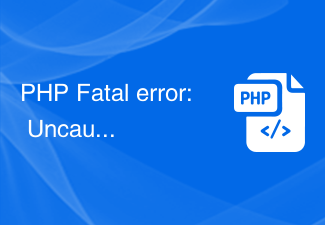通过日志记录功能,你可以将信息直接发送到其他日志服务器,或者发送到指定的电子邮箱(或者通过邮件网关发送),或者发送到操作系统日志等,从而可以有选择的记录和监视你的应用程序和网站的最重要的部分。
错误报告功能允许你自定义错误反馈的级别和类型,可以是简单的提示信息或者使用自定义的函数进行处理并返回信息.
为什么要使用错误处理?
1.是网站出错时对用户友好
2.更好的避免错误、调试、修复错误
3.避免一些安全风险
4.更好保证程序的健壮性
5.……
一、最简单的错误处理――die()
当我们预计有错误发生时,停止脚步的运行。比如连接数据库时:
mysql_connect('localhost', 'root', '123456') or die ('连接数据库错误:'. mysql_error());
不过,简单地终止脚本并不总是恰当的方式。
二、自定义错误和错误触发器
我们创建一个错误处理专用函数,使用set_error_handler函数设置后,可以在 PHP 中发生错误时调用该函数。
1.定义错误处理函数的参数:
| 参数 | 描述 |
|---|---|
| error_level | 必需。为用户定义的错误规定错误报告级别。必须是一个值数。
参见下面的表格:错误报告级别。 |
| error_message | 必需。为用户定义的错误规定错误消息。 |
| error_file | 可选。规定错误在其中发生的文件名。 |
| error_line | 可选。规定错误发生的行号。 |
| error_context | 可选。规定一个数组,包含了当错误发生时在用的每个变量以及它们的值。 |
2. Error basic predefined constants:
| Value | Constant | Description | Remarks |
|---|---|---|---|
| 1 | E_ERROR (integer) | Fatal runtime error. This type of error is generally an unrecoverable situation, such as a problem caused by memory allocation. The consequence is that the script terminates and does not continue to run. | |
| 2 | E_WARNING (integer) | Runtime warning (non-fatal error). Only a prompt message is given, but the script does not terminate. | |
| 4 | E_PARSE (integer) | Compile time syntax parsing error. Parsing errors are generated only by the parser. | |
| 8 | E_NOTICE (integer) | Runtime notification. Indicates that the script encounters a situation that may appear as an error, but there may also be similar notifications in scripts that can run normally. | |
| 16 | E_CORE_ERROR (integer) | Fatal error occurred during PHP initialization startup. This error is similar to E_ERROR, but is generated by the PHP engine core. | since PHP 4 |
| 32 | E_CORE_WARNING(integer) | Warning (non-fatal error) that occurred during PHP initialization startup. Similar to E_WARNING, but generated by the PHP engine core. | since PHP 4 |
| 64 | E_COMPILE_ERROR(integer) | Fatal compile-time error. Similar to E_ERROR, but generated by the Zend script engine. | since PHP 4 |
| 128 | E_COMPILE_WARNING(integer) | Compile-time warning (non-fatal error). Similar to E_WARNING, but generated by the Zend script engine. | since PHP 4 |
| 256 | E_USER_ERROR (integer) | User-generated error message. Similar to E_ERROR, but it is generated by the user using the PHP function trigger_error() in the code. | since PHP 4 |
| 512 | E_USER_WARNING(integer) | User-generated warning message. Similar to E_WARNING, but it is generated by the user using the PHP function trigger_error() in the code. | since PHP 4 |
| 1024 | E_USER_NOTICE(integer) | Notification messages generated by users. Similar to E_NOTICE, but it is generated by the user using the PHP function trigger_error() in the code. | since PHP 4 |
| 2048 | E_STRICT (integer) | Enable PHP's suggested modifications to your code to ensure optimal interoperability and forward compatibility. | since PHP 5 |
| 4096 | E_RECOVERABLE_ERROR(integer) | 可被捕捉的致命错误。 它表示发生了一个可能非常危险的错误,但是还没有导致PHP引擎处于不稳定的状态。 如果该错误没有被用户自定义句柄捕获 (参见 set_error_handler()),将成为一个 E_ERROR 从而脚本会终止运行。 | since PHP 5.2.0 |
| 8192 | E_DEPRECATED (integer) | 运行时通知。启用后将会对在未来版本中可能无法正常工作的代码给出警告。 | since PHP 5.3.0 |
| 16384 | E_USER_DEPRECATED(integer) | 用户产少的警告信息。 类似E_DEPRECATED, 但是是由用户自己在代码中使用PHP函数 trigger_error()来产生的。 | since PHP 5.3.0 |
| 30719 | E_ALL (integer) | E_STRICT出外的所有错误和警告信息。 | 30719 in PHP 5.3.x, 6143 in PHP 5.2.x, 2047 previously |
(Levels E_ERROR and E_USER_ERROR cannot be caught by custom error handling functions) Fatal error messages cannot be caught in custom error functions because the script stops execution immediately when a fatal runtime error occurs.
3. Trigger errors
In the script where the user inputs data, it is useful to trigger an error when the user's input is invalid. In PHP, this task is accomplished by trigger_error().
You can trigger errors anywhere in the script. By adding a second parameter, you can specify the error level that is triggered.
4. Possible error types:
1).E_USER_ERROR - Fatal user-generated run-time error. The error cannot be recovered. Script execution was interrupted.
2).E_USER_WARNING - Non-fatal user-generated run-time warning. Script execution is not interrupted.
3).E_USER_NOTICE - Default. User-generated run-time notifications. The script found a possible error, which may have occurred while the script was running normally.
For example:
trigger_error("Something went wrong", E_USER_WARNING);
// Output Warning: Something went wrong in xxxx error message
3. Error reporting
By default, according to the error_log configuration in php.ini, PHP sends error records to the server's error recording system or file.
By using the error_log() function, you can send error records to a specified file or remote destination. For example, sending error messages to email is a good way.
For more error handling documentation, see: http://www.php.net/manual/zh/book.errorfunc.php
4. Exception handling
When an exception is thrown, the subsequent code will not continue to execute, and PHP will try to find a matching "catch" code block.
If the exception is not caught and there is no need to use set_exception_handler() for corresponding processing, then a serious error (fatal error) will occur and an "Uncaught Exception" error message will be output.
1. The processing procedure should include:
1.) try - Functions that use exceptions should be inside a "try" block. If no exception is triggered, the code continues execution as usual. But if an exception is triggered, an exception will be thrown.
2.) throw - This specifies how to trigger the exception. Each "throw" must correspond to at least one "catch"
3.) catch - The "catch" code block will catch the exception and create an object containing the exception information
2. Rethrow the exception
Sometimes, when an exception is thrown, you may want to handle it differently than the standard. The exception can be thrown again in a "catch" block.
The script should hide system errors from the user. System errors may be important to programmers, but users are not interested in them. To make it easier for users, you can throw the exception again with a user-friendly message.
3. Abnormal rules
1). Code that requires exception handling should be placed within a try code block to catch potential exceptions.
2). Each try or throw code block must have at least one corresponding catch code block.
3). Use multiple catch code blocks to catch different types of exceptions.
4).Exceptions can be re-thrown in the catch code block within the try code block.
In short: if an exception is thrown, you must catch it.
 PHP Fatal error: Uncaught exception 'Exception'解决方法Aug 18, 2023 pm 03:28 PM
PHP Fatal error: Uncaught exception 'Exception'解决方法Aug 18, 2023 pm 03:28 PMPHP是一种广泛使用的服务器端编程语言,它可以为网站提供强大的动态功能。但是,在实践中,开发人员可能会遇到各种各样的错误和异常。其中一个常见的错误是PHPFatalerror:Uncaughtexception'Exception'。在本文中,我们将探讨这个错误的原因以及如何解决它。异常的概念在PHP中,异常是指程序在运行过程中遇到的意外情况,导致
 PHP异常处理技巧:如何使用try...catch块捕获和处理多个异常Jul 29, 2023 pm 01:05 PM
PHP异常处理技巧:如何使用try...catch块捕获和处理多个异常Jul 29, 2023 pm 01:05 PMPHP异常处理技巧:如何使用try...catch块捕获和处理多个异常引言:在PHP应用程序开发中,异常处理是非常重要的一环。当代码中发生错误或异常时,合理的异常处理能够提高程序的健壮性和可靠性。本文将介绍如何使用try...catch块捕获和处理多个异常,帮助开发者进行更加灵活和高效的异常处理。异常处理介绍异常是指在程序运行时产生的错误或特殊情况。当异常出
 PHP中的错误处理机制是什么?May 12, 2023 pm 07:31 PM
PHP中的错误处理机制是什么?May 12, 2023 pm 07:31 PMPHP是一种流行而强大的服务器端编程语言,可以用来开发各种Web应用程序。就像其他编程语言一样,PHP也有可能会出现错误和异常。这些错误和异常可能由各种原因引起,如程序错误、服务器错误、用户输入错误等等。为了确保程序的运行稳定性和可靠性,PHP提供了一套完整的错误处理机制。PHP错误处理机制的基本思想是:当发生错误时,程序会停止执行并输出一条错误消息。我们可
 PHP程序中的异常分类最佳实践Jun 06, 2023 am 08:01 AM
PHP程序中的异常分类最佳实践Jun 06, 2023 am 08:01 AM在编写PHP代码时,异常处理是不可或缺的一部分,它可以使代码更加健壮和可维护。但是,异常处理也需要谨慎使用,否则就可能带来更多的问题。在这篇文章中,我将分享一些PHP程序中异常分类的最佳实践,以帮助你更好地利用异常处理来提高代码质量。异常的概念在PHP中,异常是指在程序运行时发生的错误或意外情况。通常情况下,异常会导致程序停止运行并输出异常信息。
 使用PHP异常和容错机制的方法?Jun 30, 2023 am 10:13 AM
使用PHP异常和容错机制的方法?Jun 30, 2023 am 10:13 AM如何使用PHP的异常处理和容错机制?引言:在PHP编程中,异常处理和容错机制是非常重要的。当代码执行过程中出现错误或异常的时候,可以使用异常处理来捕获和处理这些错误,以保证程序的稳定性和可靠性。本文将介绍如何使用PHP的异常处理和容错机制。一、异常处理基础知识:什么是异常?异常是在代码执行过程中出现的错误或异常情况,包括语法错误、运行时错误、逻辑错误等。当异
 如何在PHP后端功能开发中实现全局异常处理?Aug 05, 2023 pm 03:36 PM
如何在PHP后端功能开发中实现全局异常处理?Aug 05, 2023 pm 03:36 PM如何在PHP后端功能开发中实现全局异常处理?在PHP后端开发中,异常处理是非常重要的一环。它可以帮助我们捕获程序中的错误,并进行适当的处理,从而提高系统的稳定性和性能。本文将介绍如何在PHP后端功能开发中实现全局异常处理,并提供相应的代码示例。PHP提供了异常处理的机制,我们可以通过try和catch关键字来捕获异常并进行相应的处理。全局异常处理指的是将所有
 PHP实现API时如何处理数据异常和错误处理策略Jun 17, 2023 am 08:12 AM
PHP实现API时如何处理数据异常和错误处理策略Jun 17, 2023 am 08:12 AM随着API的使用越来越广泛,我们在开发和使用API过程中也需要考虑到数据异常和错误处理的策略。本文将探讨PHP实现API时如何处理这些问题。一、处理数据异常数据异常出现的原因可能有很多,比如用户输入错误、网络传输错误、服务器内部错误等等。在PHP开发时,我们可以使用以下方法来处理数据异常。返回合适的HTTP状态码HTTP协议定义了很多状态码,可以帮助我们在处
 PHP时间处理异常:返回时间出错Mar 28, 2024 pm 01:51 PM
PHP时间处理异常:返回时间出错Mar 28, 2024 pm 01:51 PMPHP时间处理异常:返回时间出错,需要具体代码示例在Web开发中,对时间的处理是一个很常见的需求。PHP作为一种常用的服务器端脚本语言,提供了丰富的时间处理函数和方法。然而,在实际应用中,有时会遇到返回时间出错的异常情况,这可能是由于代码中的错误或不当使用造成的。在本文中,我们将介绍一些可能导致返回时间出错的常见情况,并提供一些具体的代码示例来帮助读者更好地


Hot AI Tools

Undresser.AI Undress
AI-powered app for creating realistic nude photos

AI Clothes Remover
Online AI tool for removing clothes from photos.

Undress AI Tool
Undress images for free

Clothoff.io
AI clothes remover

AI Hentai Generator
Generate AI Hentai for free.

Hot Article

Hot Tools

SAP NetWeaver Server Adapter for Eclipse
Integrate Eclipse with SAP NetWeaver application server.

PhpStorm Mac version
The latest (2018.2.1) professional PHP integrated development tool

DVWA
Damn Vulnerable Web App (DVWA) is a PHP/MySQL web application that is very vulnerable. Its main goals are to be an aid for security professionals to test their skills and tools in a legal environment, to help web developers better understand the process of securing web applications, and to help teachers/students teach/learn in a classroom environment Web application security. The goal of DVWA is to practice some of the most common web vulnerabilities through a simple and straightforward interface, with varying degrees of difficulty. Please note that this software

SublimeText3 English version
Recommended: Win version, supports code prompts!

ZendStudio 13.5.1 Mac
Powerful PHP integrated development environment






